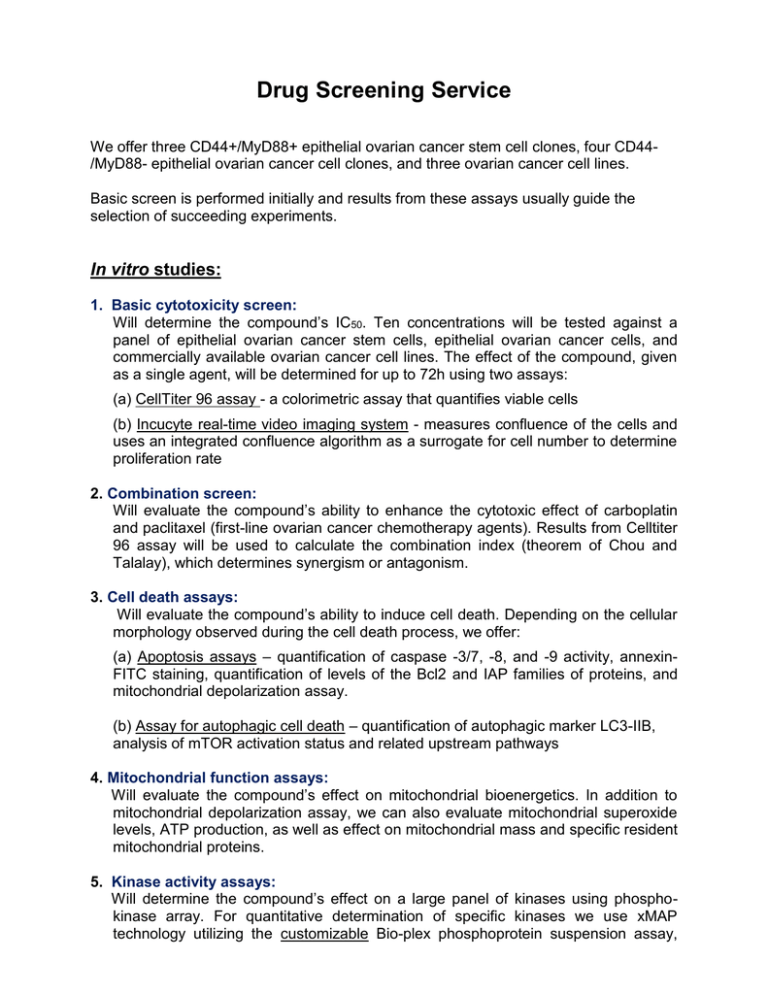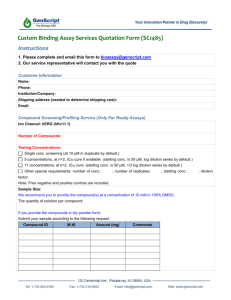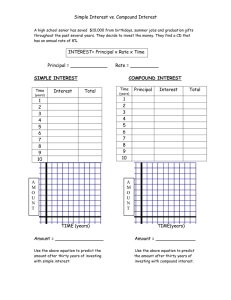87_164491_Services Reprod Imm core
advertisement

Drug Screening Service We offer three CD44+/MyD88+ epithelial ovarian cancer stem cell clones, four CD44/MyD88- epithelial ovarian cancer cell clones, and three ovarian cancer cell lines. Basic screen is performed initially and results from these assays usually guide the selection of succeeding experiments. In vitro studies: 1. Basic cytotoxicity screen: Will determine the compound’s IC50. Ten concentrations will be tested against a panel of epithelial ovarian cancer stem cells, epithelial ovarian cancer cells, and commercially available ovarian cancer cell lines. The effect of the compound, given as a single agent, will be determined for up to 72h using two assays: (a) CellTiter 96 assay - a colorimetric assay that quantifies viable cells (b) Incucyte real-time video imaging system - measures confluence of the cells and uses an integrated confluence algorithm as a surrogate for cell number to determine proliferation rate 2. Combination screen: Will evaluate the compound’s ability to enhance the cytotoxic effect of carboplatin and paclitaxel (first-line ovarian cancer chemotherapy agents). Results from Celltiter 96 assay will be used to calculate the combination index (theorem of Chou and Talalay), which determines synergism or antagonism. 3. Cell death assays: Will evaluate the compound’s ability to induce cell death. Depending on the cellular morphology observed during the cell death process, we offer: (a) Apoptosis assays – quantification of caspase -3/7, -8, and -9 activity, annexinFITC staining, quantification of levels of the Bcl2 and IAP families of proteins, and mitochondrial depolarization assay. (b) Assay for autophagic cell death – quantification of autophagic marker LC3-IIB, analysis of mTOR activation status and related upstream pathways 4. Mitochondrial function assays: Will evaluate the compound’s effect on mitochondrial bioenergetics. In addition to mitochondrial depolarization assay, we can also evaluate mitochondrial superoxide levels, ATP production, as well as effect on mitochondrial mass and specific resident mitochondrial proteins. 5. Kinase activity assays: Will determine the compound’s effect on a large panel of kinases using phosphokinase array. For quantitative determination of specific kinases we use xMAP technology utilizing the customizable Bio-plex phosphoprotein suspension assay, which includes kinases that are known to be important for ovarian cancer stem cell survival. 6. Cytokine/chemokine profiling: Will determine the compound’s effect on the constitutive secretion of proinflammatory cytokines/chemokines by the ovarian cancer stem cells. This assay also uses xMAP technology and the customizable Bio-plex multiplex cytokine assay. We have optimized a 17-plex panel, which can be further expanded. 7. Cellular migration and invasion assays: (a) Wound healing test will determine the compound’s ability to enhance or inhibit the capacity of ovarian cancer stem cells to heal/repair in vitro scratch wound. This assay utilizes the WoundMaker™, which generates straight and equivalent “scratch wounds” on confluent cultures of cells. The “healing/repair” response is monitored in real-time by measurement of the wound width. (b) In vitro migration test will determine the compound’s ability to enhance or inhibit the migration of ovarian cancer stem cells to through a membrane. Migrating cells are counted by Volocity software (Perkin Elmer). (c) In vitro invasion test will determine the compound’s ability to enhance or inhibit the invasion of ovarian cancer stem cells to through Matrigel, an artificial extracellular matrix. Invading cells are counted by Volocity software (Perkin Elmer). 8. Angiogenesis assay: Will determine if the compound can enhance or inhibit the capacity of ovarian cancer stem cells to form vessel-like structures in 3D-Matrigel. 9. Target identification assays: (a) qPCR Pathway Array: will identify the key pathway affected by the compound. We utilize the RT2 Profiler PCR arrays, which analyze the expression of a panel of genes involved in specific biological pathways. (b) Loss-of-function drug modulation cell viability assay: uses the Dharmacon siGenome human siRNA library to identify genes associated with the mechanism of action of a given cytotoxic compound by looking for gene knockdowns that confer differential resistance to treatment. Kinase library (719 genes) Genome-wide library (18,199 genes) Animal Studies: Subcutaneous model 1. Single-agent tumorigenicity assay/subcutaneous model: Will determine the effect of the compound given as single agent on tumor kinetics. Paclitaxel will be used as control. Tumor size will be measured by caliper measurements. Alternatively, we also offer weekly live-imaging using a fluorescent tumor model imaged with Bruker In-vivo Imaging System. 2. Combination tumorigenicity assay/subcutaneous model: Will determine the ability of the compound to synergize with Carboplatin and Paclitaxel. Intraperitoneal model 3. 1st- line treatment Will evaluate the effect of the compound as 1st-line treatment using our fluorescently labeled ovarian cancer cells. The model consists of mCherry-labeled ovarian cancer cells injected in the peritoneum of immune-incompetent mice. The presence of mCherry-positive cells in the peritoneum and ovaries allows the monitoring of chemoresponse without the need to sacrifice the mice. The model is characterized by an early response to Paclitaxel treatment. Thus, this model will be able to compare the activity of the compound with Paclitaxel given as a single agent or in combination and will determine the effect on progression-free survival. 4. Second-line treatment Uses the same i.p. model as above. As mentioned, this model is characterized by an early response to Paclitaxel treatment. However, upon conclusion of treatment, recurrence occurs within a few weeks. Upon recurrence, tumors become resistant to Paclitaxel. Thus, this model will determine if the compound has superior activity than Paclitaxel in the recurrent setting. 5. Recurrence model Uses the same i.p. model as above. After the initial response to Paclitaxel, mice will be maintained with either vehicle or the compound to determine if the compound can prevent or delay recurrence. End-point is days to recurrence. 6. Validation of in vivo drug targets: Will validate the in vitro molecular targets in the xenografts. For both in vitro and in vivo experiments, first payment (50%) is given at the initiation of the study and the balance is paid at the completion of each phase.





